Environmental Management System for the Analysis of Oil Spill Risk Using Probabilistic Simulations. Application at Tarragona Monobuoy
Abstract
1. Introduction
2. Materials and Methods
2.1. Study Area
2.2. Meteo-Oceanographic Services
2.3. Probabilistic Risk Management
3. Results
4. Discussion
4.1. Numerical Resolution Comparison
4.2. Temporal Variability and Hydrodynamic Considerations
- For spills released at 04:00, the high probability area was slightly displaced away from the coast and the average distance reached was slightly lower.
- For spills released at 10:00, the high probability area was near the coast with a high proportion of particles trapped on the shoreline and the average distance reached was quite a lot lower.
- For spills released at 16:00, there was a wider and more uniform distribution with an average proportion of particles trapped on the coast and the average distance reached was higher.
- For spills released at 22:00, a wider and more uniform distribution (though not as much as at 16:00 spills) was observed and the average proportion of particles trapped on the shore and the average distance reached was higher.
4.3. Convergence Considerations
- The criteria should be based on relative error in probability, instead of absolute, as it will have to work consistently for different probability values.
- If the criterium takes into consideration the probability value, it must be evaluated on the estimate probability obtained at any given number of simulations.
- A criterium evaluation with low evaluation cost will be preferred so it can be evaluated after each simulation without a high increase in the time needed for calculation.
4.4. Comparison with Previous Works
4.5. Port Management Applications
5. Conclusions
Author Contributions
Funding
Acknowledgments
Conflicts of Interest
References
- Lecue, M.; Darbra, R.M. Accidents in European Ports Involving Chemical Substances: Characteristics and Trends. Saf. Sci. 2019, 115, 278–284. [Google Scholar] [CrossRef]
- Long, R. The Marine Strategy Framework Directive: A New European Approach to the Regulation of the Marine Environment, Marine Natural Resources and Marine Ecological Services. J. Energy Nat. Resour. Law 2011, 29, 1–44. [Google Scholar] [CrossRef]
- Gómez, A.G.; Ondiviela, B.; Puente, A.; Juanes, J.A. Environmental Risk Assessment of Water Quality in Harbor Areas: A New Methodology Applied to European Ports. J. Environ. Manag. 2015, 155, 77–88. [Google Scholar] [CrossRef] [PubMed]
- Valdor, P.F.; Gómez, A.G.; Puente, A. Environmental Risk Analysis of Oil Handling Facilities in Port Areas. Application to Tarragona Harbor (NE Spain). Mar. Pollut. Bull. 2015, 90, 78–87. [Google Scholar] [CrossRef] [PubMed]
- Valdor, P.F.; Gómez, A.G.; Velarde, V.; Puente, A. Can a GIS Toolbox Assess the Environmental Risk of Oil Spills? Implementation for Oil Facilities in Harbors. J. Environ. Manag. 2016, 170, 105–115. [Google Scholar] [CrossRef] [PubMed]
- Valdor, P.F.; Gómez, A.G.; Ondiviela, B.; Puente, A.; Juanes, J.A. Prioritization Maps: The Integration of Environmental Risks to Manage Water Quality in Harbor Areas. Mar. Pollut. Bull. 2016, 111, 57–67. [Google Scholar] [CrossRef]
- Xie, C.; Deng, J.; Zhuang, Y.; Sun, H. Estimating Oil Pollution Risk in Environmentally Sensitive Areas of Petrochemical Terminals Based on a Stochastic Numerical Simulation. Mar. Pollut. Bull. 2017, 123, 241–252. [Google Scholar] [CrossRef]
- Horrillo-Caraballo, J.M.; Reeve, D.E.; Simmonds, D.; Pan, S.; Fox, A.; Thompson, R.; Hoggart, S.; Kwan, S.S.H.; Greaves, D. Application of a Source-Pathway-Receptor-Consequence (S-P-R-C) Methodology to the Teign Estuary, UK. J. Coast. Res. 2013, 65 (Suppl. S2), 1939–1944. [Google Scholar] [CrossRef]
- Novelli, G. Numerical Simulation of Oil Spills in Coastal Areas Using Shallow Water Equations in Generalised Coordinates. Ph.D. Thesis, Departament d’Enginyeria Mecànica, Universitat Rovira i Virgili, Tarragona, Spain, 2011. [Google Scholar]
- Cuesta, I.; Grau, F.X.; Giralt, F. Numerical Simulation of Oil Spills in a Generalized Domain. Oil Chem. Pollut. 1990, 7, 143–159. [Google Scholar] [CrossRef]
- Sotillo, M.G.; Cerralbo, P.; Lorente, P.; Grifoll, M.; Espino, M.; Sanchez-Arcilla, A.; Álvarez-Fanjul, E. Coastal Ocean Forecasting in Spanish Ports: The SAMOA Operational Service. J. Oper. Oceanogr. 2019, 13, 37–54. [Google Scholar] [CrossRef]
- Shchepetkin, A.F.; McWilliams, J.C. The Regional Oceanic Modeling System (ROMS): A Split-Explicit, Free-Surface, Topography-Following-Coordinate Oceanic Model. Ocean Model. 2005, 9, 347–404. [Google Scholar] [CrossRef]
- Grifoll, M.; Jordà, G.; Espino, M.; Romo, J.; García-Sotillo, M. A Management System for Accidental Water Pollution Risk in a Harbour: The Barcelona Case Study. J. Mar. Syst. 2011, 88, 60–73. [Google Scholar] [CrossRef]
- Grifoll, M.; Del Campo, A.; Espino, M.; Mader, J.; González, M.; Borja, Á. Water Renewal and Risk Assessment of Water Pollution in Semi-Enclosed Domains: Application to Bilbao Harbour (Bay of Biscay). J. Mar. Syst. 2013, 109–110, S241–S251. [Google Scholar] [CrossRef]
- Lorente, P.; Piedracoba, S.; Soto-Navarro, J.; Alvarez-Fanjul, E. Evaluating the surface circulation in the Ebro delta (northeastern Spain) with quality-controlled high-frequency radar measurements. Ocean Sci. 2015, 11, 921–935. [Google Scholar] [CrossRef]
- Grifoll, M.; Jordà, G.; Borja, Á.; Espino, M. A New Risk Assessment Method for Water Quality Degradation in Harbour Domains, Using Hydrodynamic Models. Mar. Pollut. Bull. 2010, 60, 69–78. [Google Scholar] [CrossRef]
- Moreno Parra, N.; Nagi, A.; Kersten, W. Risk Assessment Methods in Seaports. A Literature Review; HAZARD Project Turku School of Economics University of Turku: Turku, Finland, 2018. [Google Scholar] [CrossRef]
- Abascal, A.J.; Castanedo, S.; Gutierrez, A.D.; Comerma, E.; Medina, R.; Losada, I.J. Teseo, an Operational System for Simulating Oil Spills Trajectories and Fate Processes. In the Seventeenth International Offshore and Polar Engineering Conference, Lisbon, Portugal 1–6 July 2007; International Society of Offshore and Polar Engineers: Mountain View, CA, USA, 2007; p. 8. [Google Scholar]
- Dominicis, M.D.; Pinardi, N. MEDSLIK-II, a Lagrangian Marine Surface Oil Spill Model for Short-Term Forecasting—Part 1: Theory. Geosci. Model Dev. 2013, 6, 1851–1869. [Google Scholar] [CrossRef]
- Dominicis, M.D.; Pinardi, N.; Zodiatis, G.; Archetti, R. MEDSLIK-II, a Lagrangian Marine Surface Oil Spill Model for Short-Term Forecasting—Part 2: Numerical Simulations and Validations. Geosci. Model Dev. 2013, 6, 1871–1888. [Google Scholar] [CrossRef]
- Goldman, R.; Biton, E.; Brokovich, E.; Kark, S.; Levin, N. Oil Spill Contamination Probability in the Southeastern Levantine Basin. Mar. Pollut. Bull. 2015, 91, 347–356. [Google Scholar] [CrossRef]
- Liubartseva, S.; De Dominicis, M.; Oddo, P.; Coppini, G.; Pinardi, N.; Greggio, N. Oil Spill Hazard from Dispersal of Oil along Shipping Lanes in the Southern Adriatic and Northern Ionian Seas. Mar. Pollut. Bull. 2015, 90, 259–272. [Google Scholar] [CrossRef]
- Al Shami, A.; Harik, G.; Alameddine, I.; Bruschi, D.; Garcia, D.A.; El-Fadel, M. Risk Assessment of Oil Spills along the Mediterranean Coast: A Sensitivity Analysis of the Choice of Hazard Quantification. Sci. Total Environ. 2017, 574, 234–245. [Google Scholar] [CrossRef]
- Neves, A.A.S.; Pinardi, N.; Martins, F.; Janeiro, J.; Samaras, A.; Zodiatis, G.; De Dominicis, M. Towards a Common Oil Spill Risk Assessment Framework—Adapting ISO 31000 and Addressing Uncertainties. J. Environ. Manag. 2015, 159, 158–168. [Google Scholar] [CrossRef] [PubMed]
- Mestres, M. A high-resolution operational system for oil spill forecasting in Spanish ports. 2020. Un-published. [Google Scholar]
- Matsuzaki, Y.; Fujita, I. In Situ Estimates of Horizontal Turbulent Diffusivity at the Sea Surface for Oil Transport Simulation. Mar. Pollut. Bull. 2017, 117, 34–40. [Google Scholar] [CrossRef] [PubMed]
- Dominicis, M.D.; Leuzzi, G.; Monti, P.; Pinardi, N.; Poulain, P.-M. Eddy Diffusivity Derived from Drifter Data for Dispersion Model Applications. Ocean Dyn. 2012, 62, 1381–1398. [Google Scholar] [CrossRef]
- Grifoll, M.; Aretxabaleta, A.L.; Espino, M.; Warner, J.C. Along-Shelf Current Variability on the Catalan Inner-Shelf (NW Mediterranean). J. Geophys. Res. Oceans 2012, 117. [Google Scholar] [CrossRef]
- Grifoll, M.; Aretxabaleta, A.L.; Pelegrí, J.L.; Espino, M.; Warner, J.C.; Sánchez-Arcilla, A. Seasonal Circulation over the Catalan Inner-Shelf (Northwest Mediterranean Sea). J. Geophys. Res. Oceans 2013, 118, 5844–5857. [Google Scholar] [CrossRef]
- Grifoll, M.; Aretxabaleta, A.L.; Espino, M. Shelf Response to Intense Offshore Wind. J. Geophys. Res. Oceans 2015, 120, 6564–6580. [Google Scholar] [CrossRef]
- Ràfols, L.; Grifoll, M.; Jordà, G.; Espino, M.; Sairouní, A.; Bravo, M. Shelf Circulation Induced by an Orographic Wind Jet. J. Geophys. Res. Oceans 2017, 122, 8225–8245. [Google Scholar] [CrossRef]
- Ràfols, L.; Pallares, E.; Espino, M.; Grifoll, M.; Sánchez-Arcilla, A.; Bravo, M.; Sairouní, A. Wind-Wave Characterization in a Wind-Jet Region: The Ebro Delta Case. J. Mar. Sci. Eng. 2017, 5, 12. [Google Scholar] [CrossRef]
- Brooks, S.P.; Roberts, G.O. Convergence Assessment Techniques for Markov Chain Monte Carlo. Stat. Comput. 1998, 8, 319–335. [Google Scholar] [CrossRef]
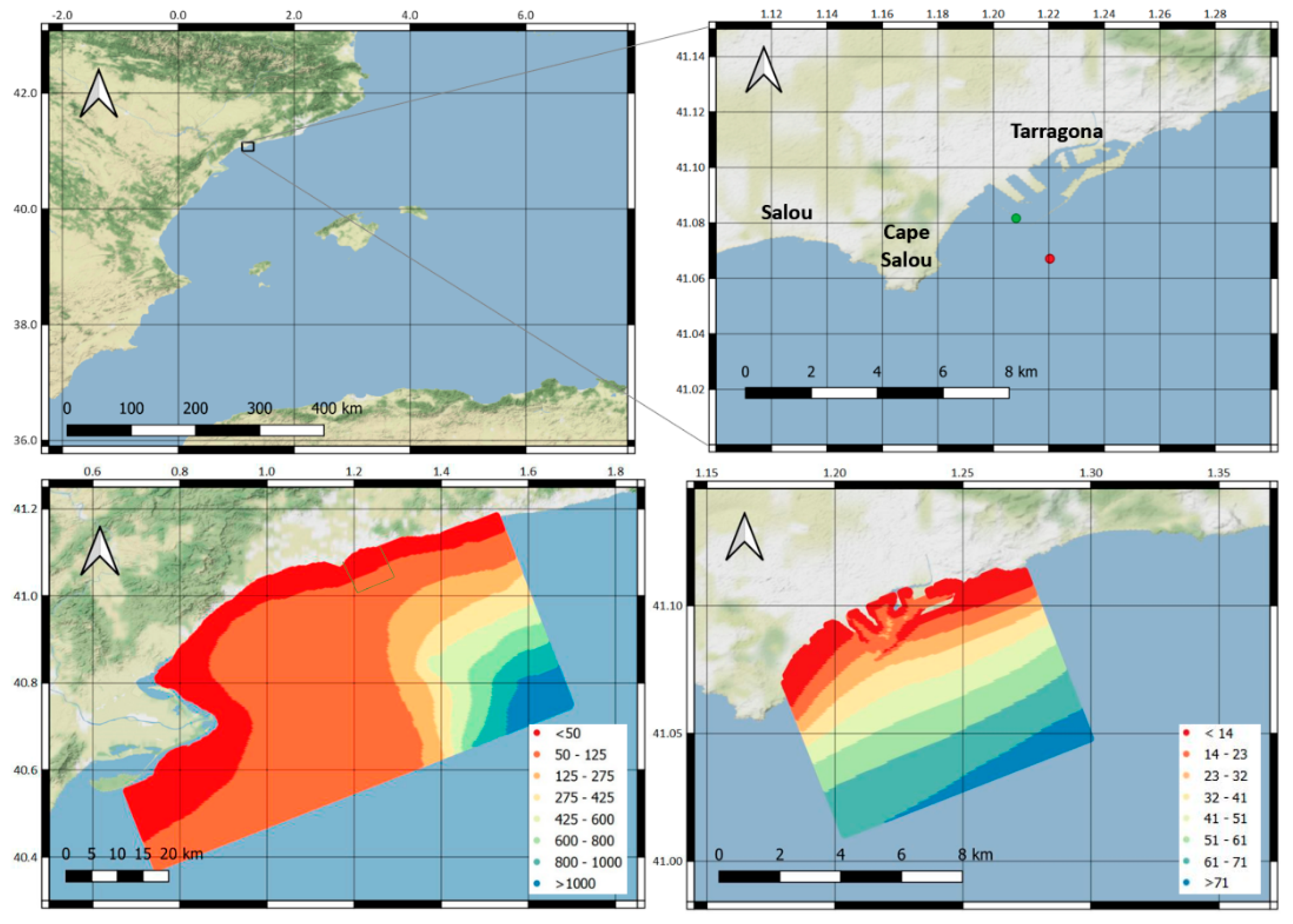
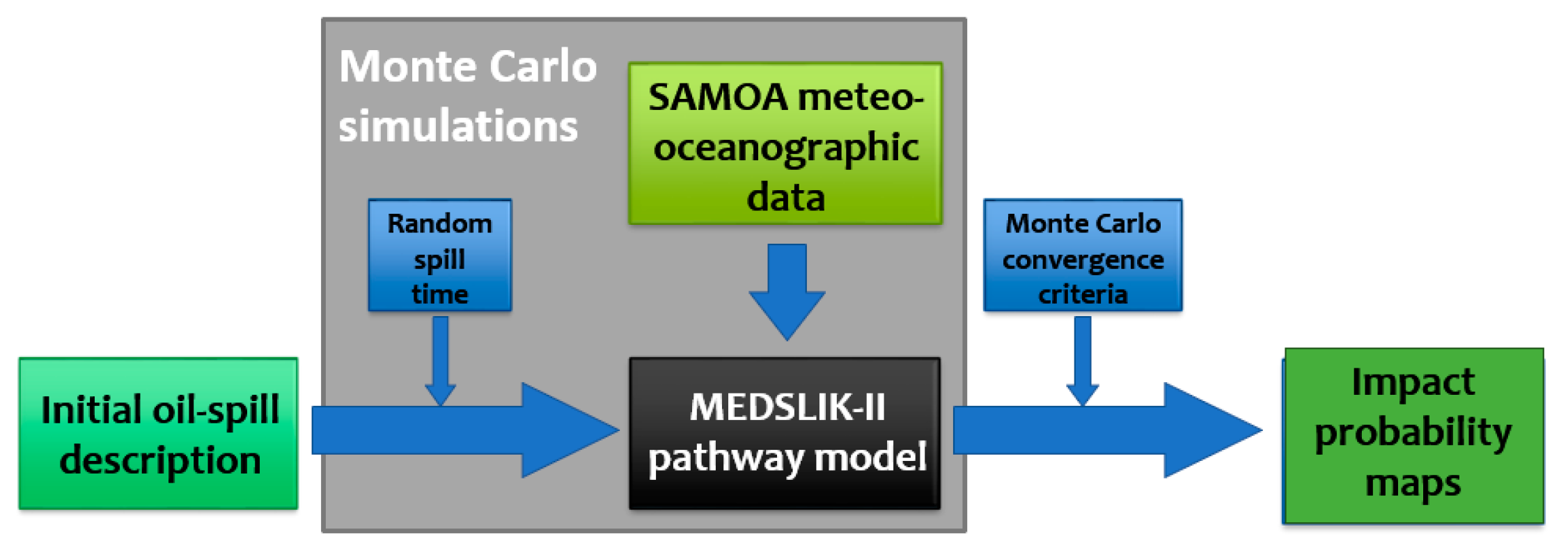
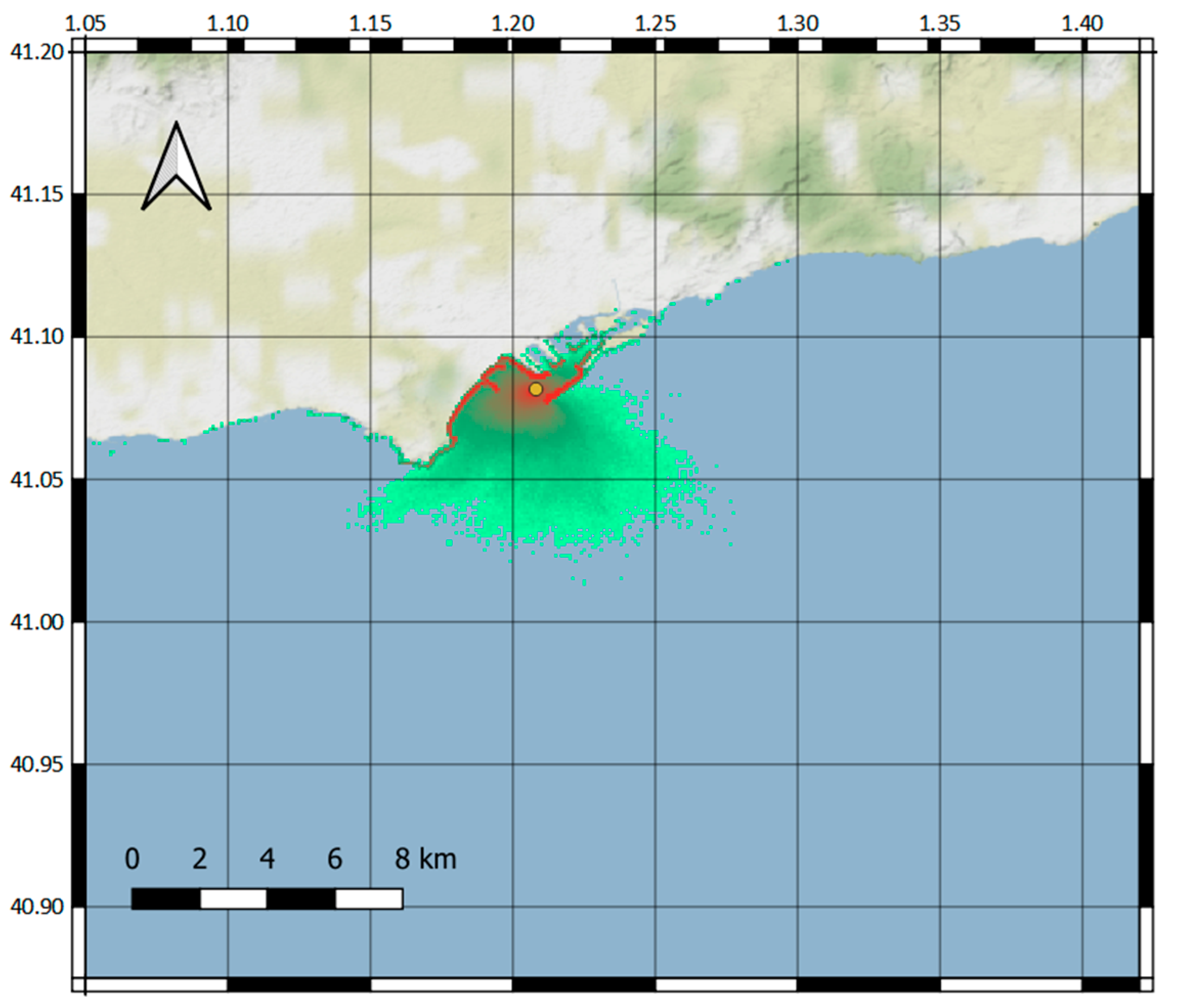
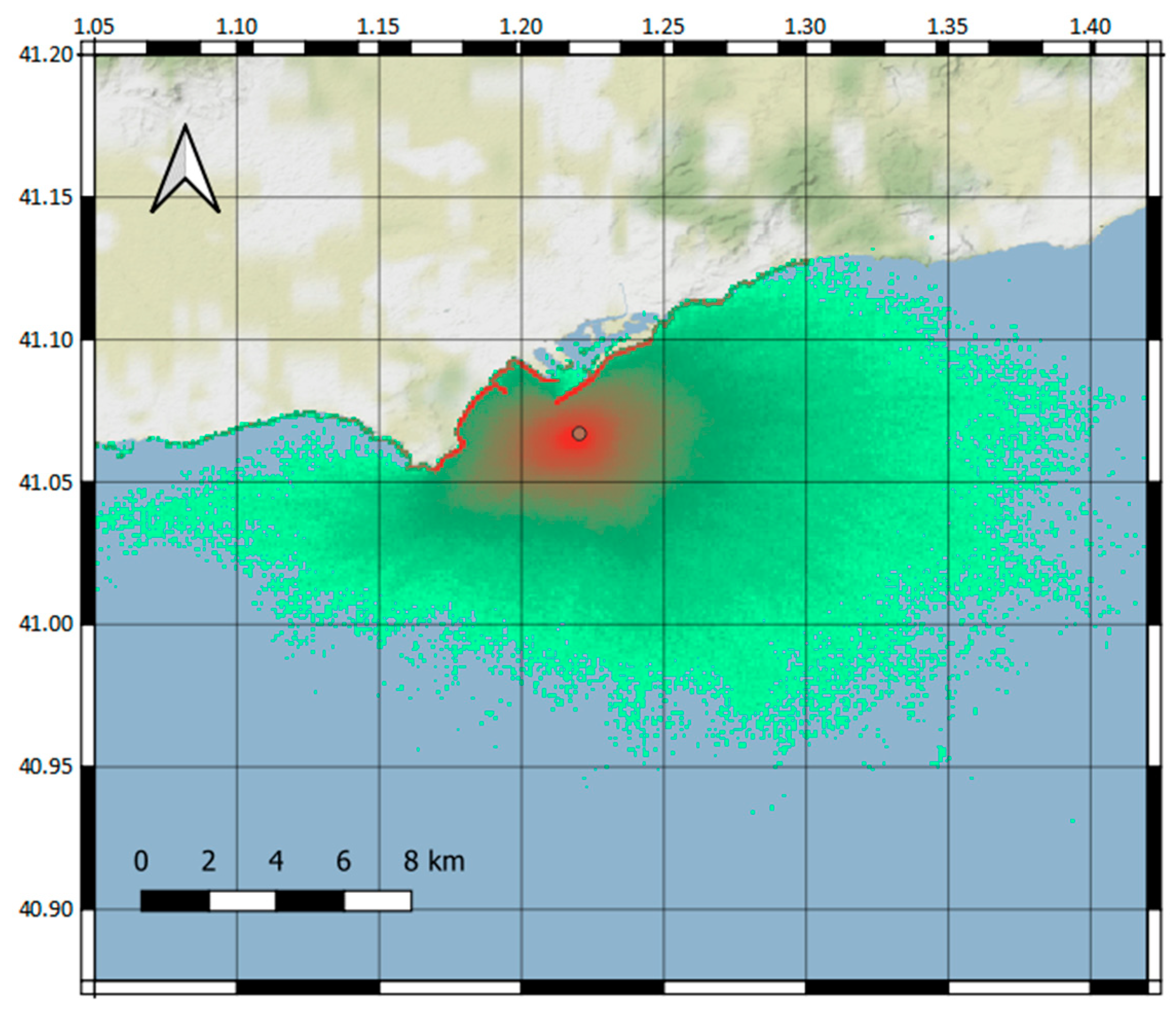
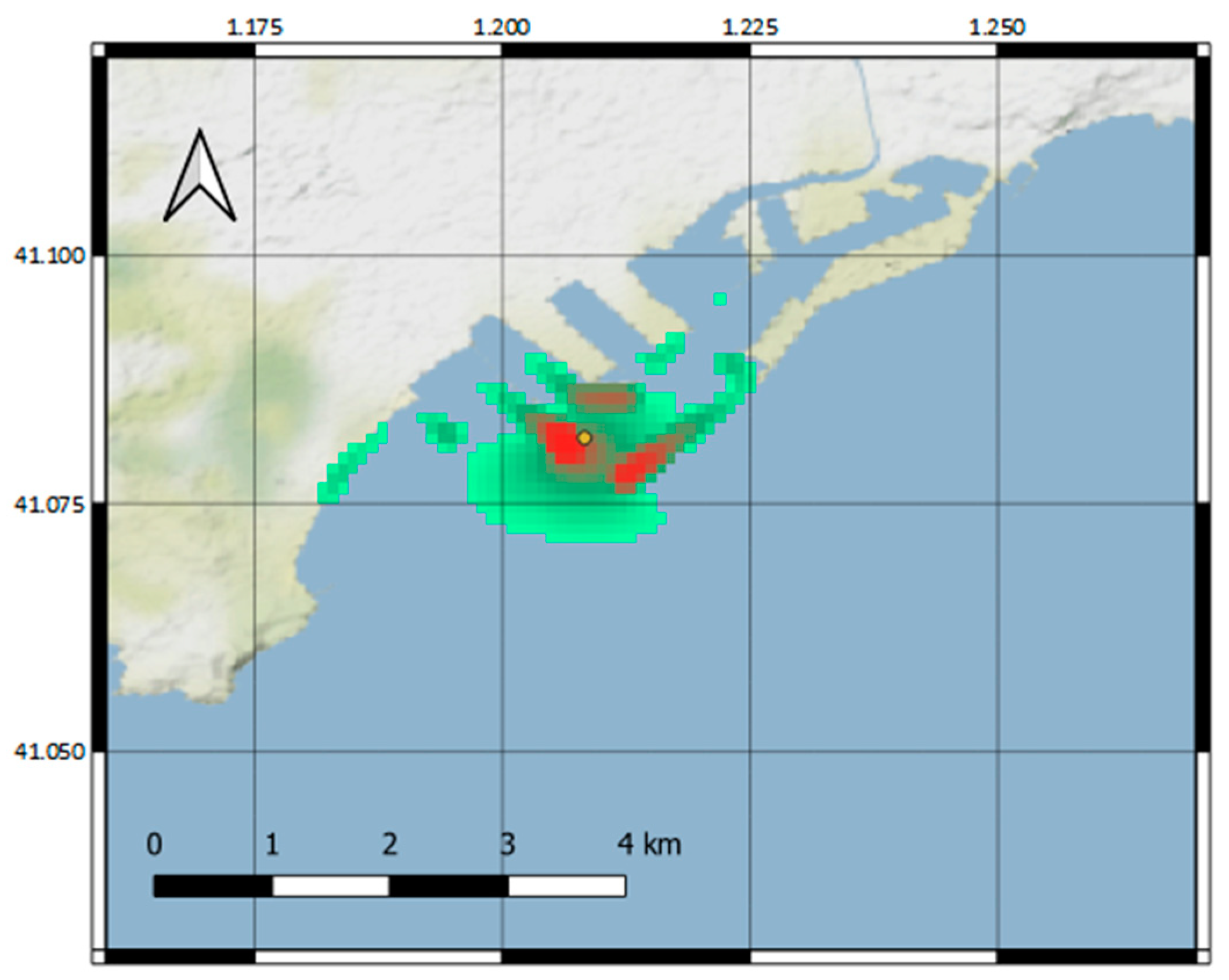
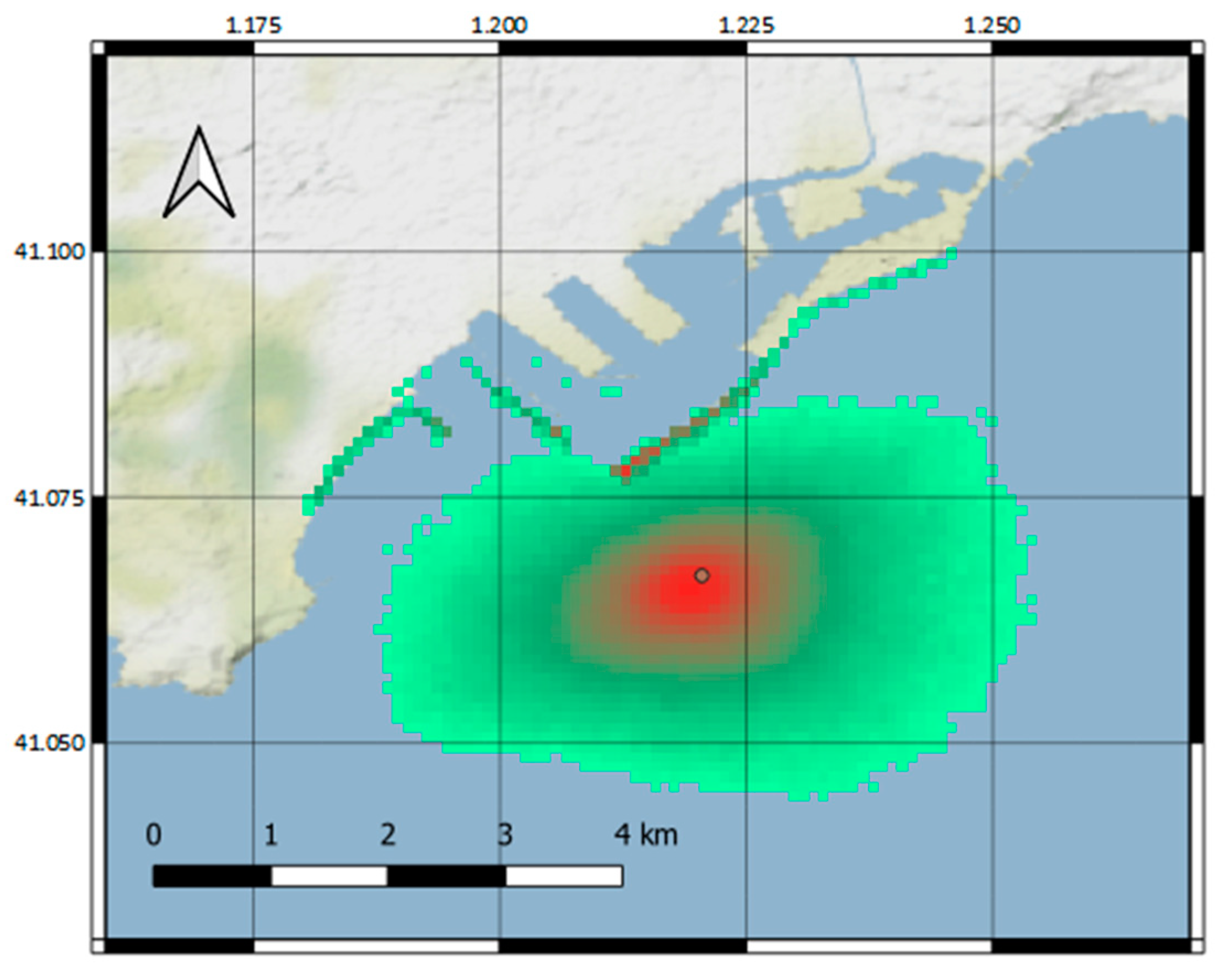
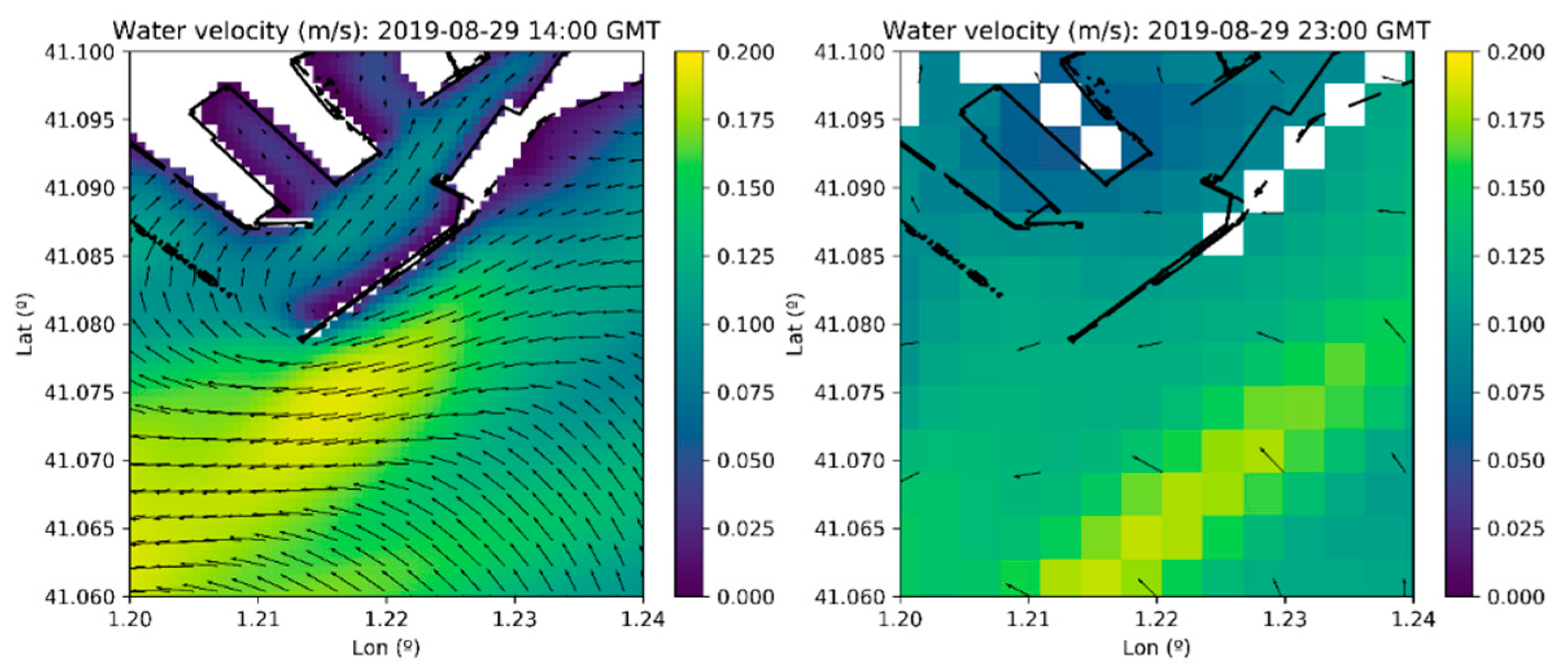
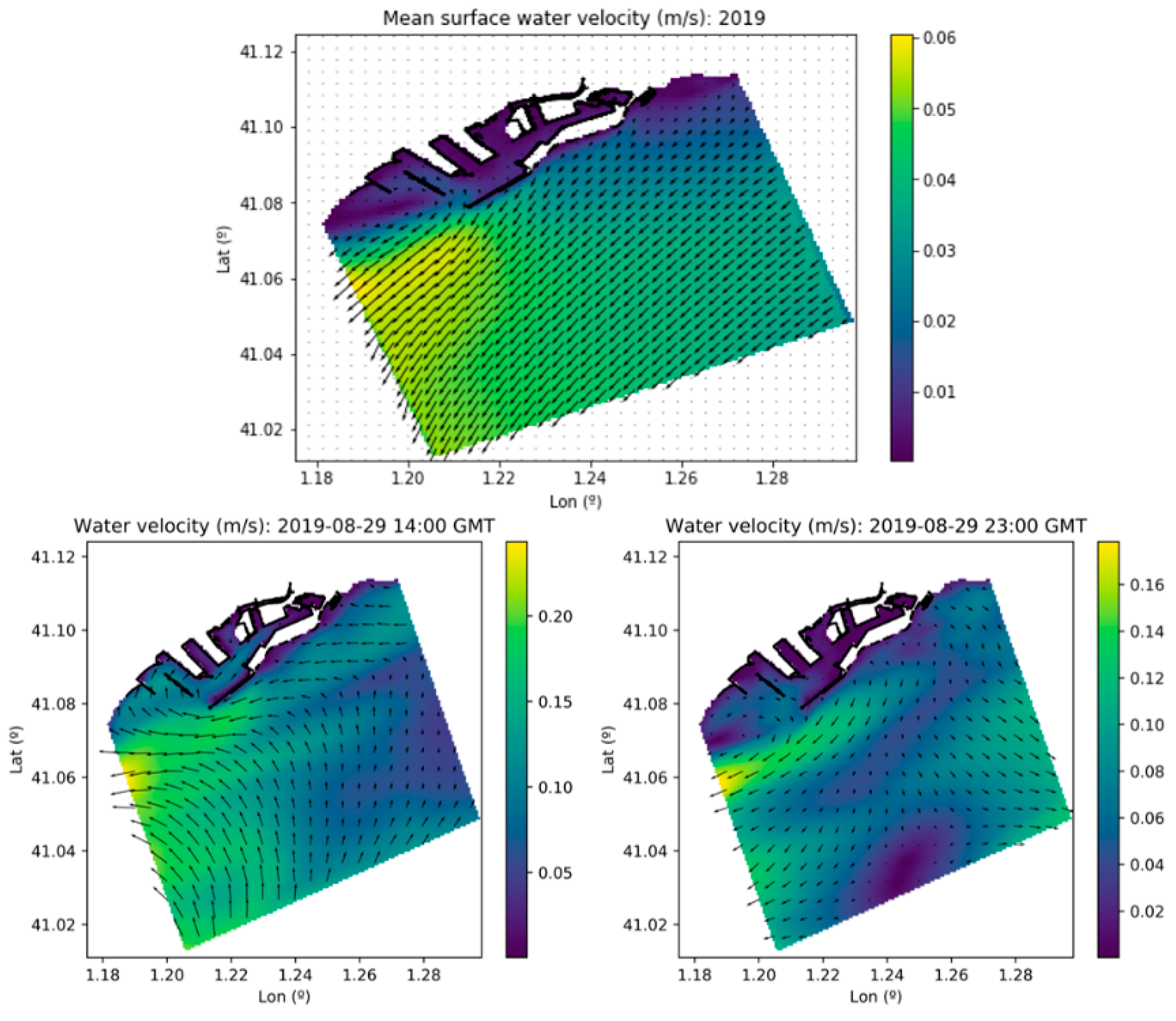
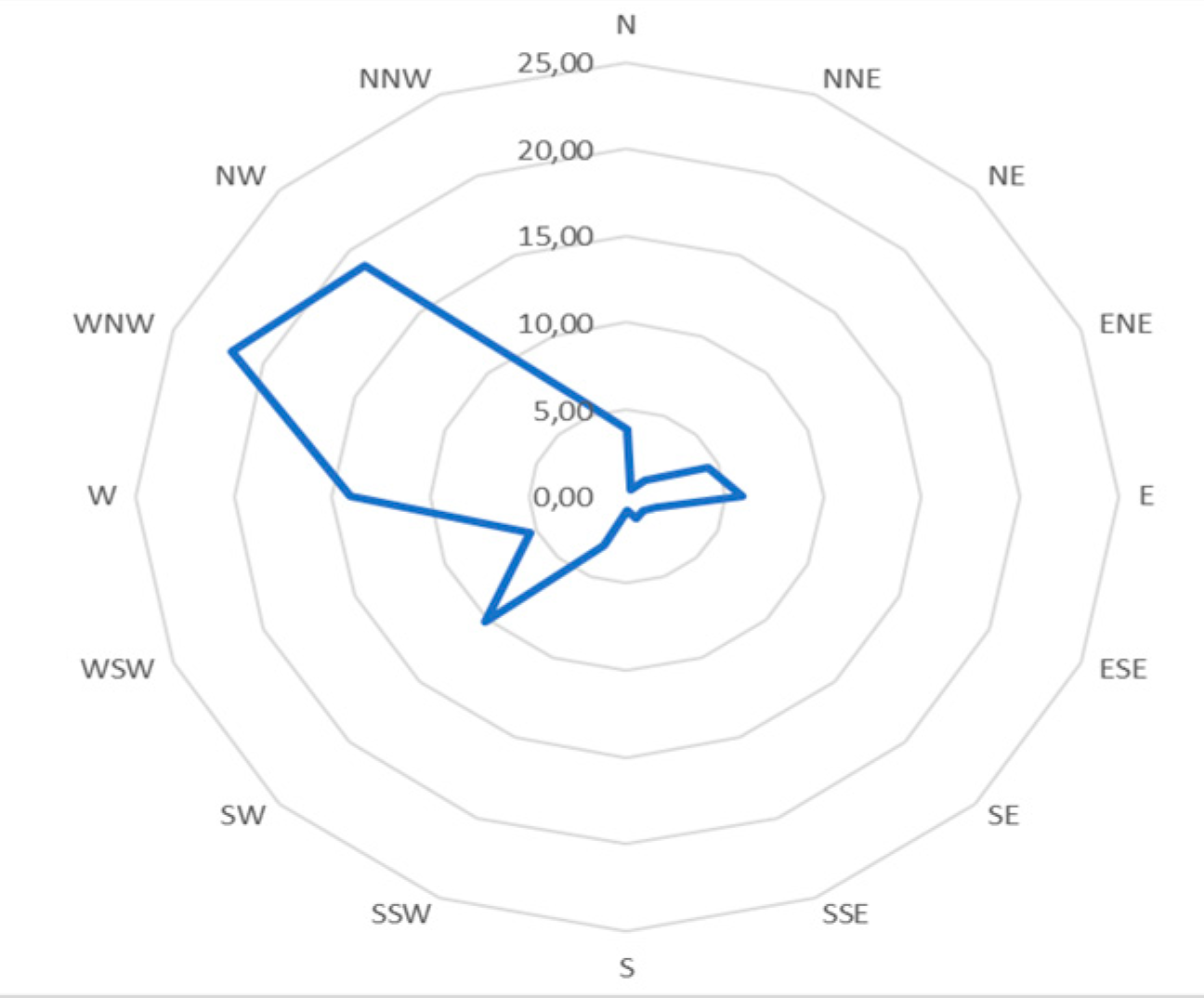

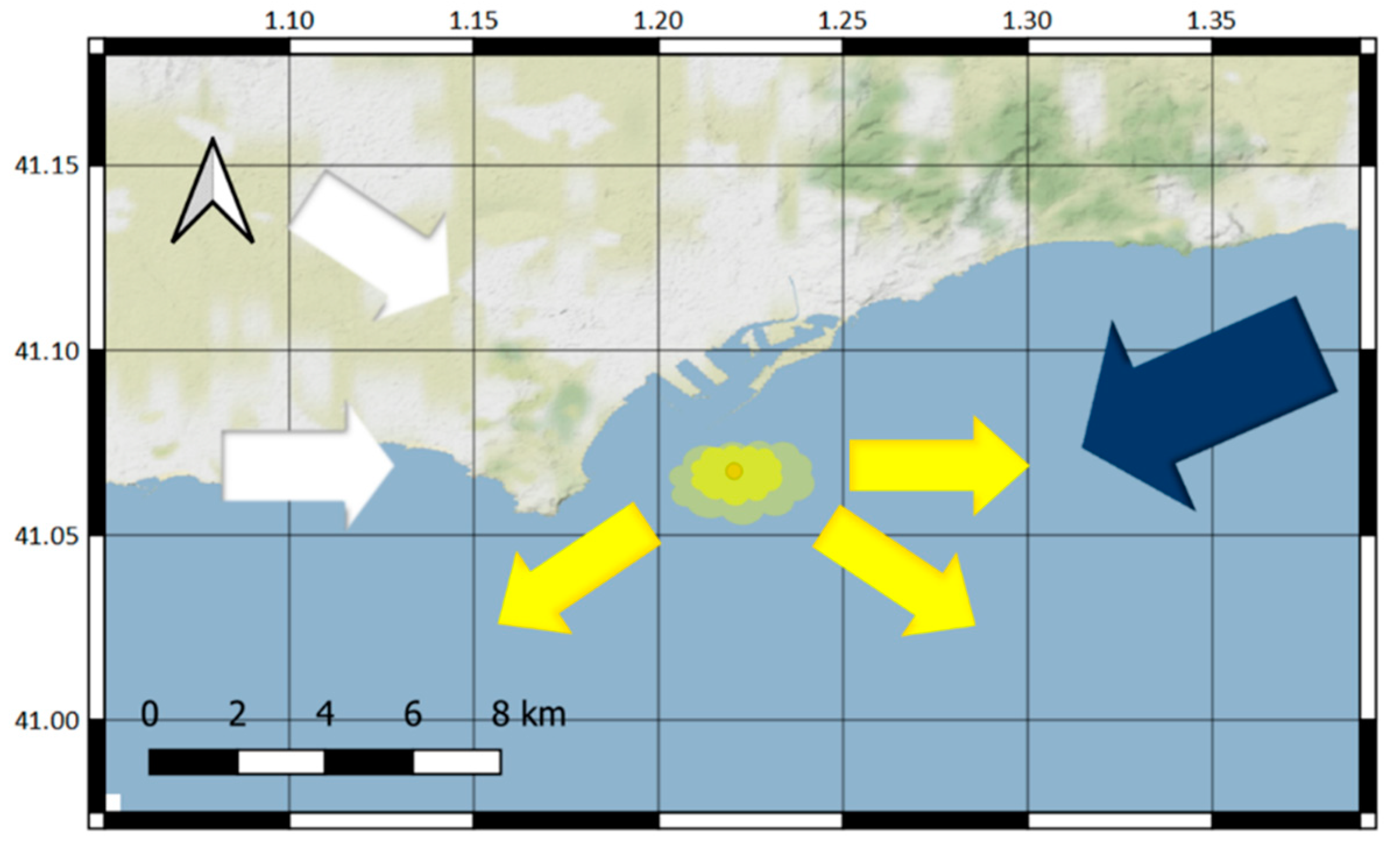
| Domain | With Dispersion (D) | Without Dispersion (N) |
|---|---|---|
| Port (P) | PD | PN |
| Coast (C) | CD | CN |
| Parameter | PD | CD | PN | CN |
|---|---|---|---|---|
| Steps/hour 1 | 82 | 10 | 82 | 10 |
| Interval 2 | 0.05 | 0.1 | 0.05 | 0.1 |
| Parcels 3 | 10 | 10 | 1 | 1 |
| Hz diffusivity 4 | 10 | 10 | 0 | 0 |
| Duration 5 | 4 | 8 | 4 | 8 |
| Probability | 2 Hits | 5 Hits | 8 Hits | 9 Hits | 10 Hits | 11 Hits |
|---|---|---|---|---|---|---|
| 50% | 0.333 | 0.111 | 0.067 | 0.059 | 0.053 | 0.048 |
| 25% | 0.429 | 0.158 | 0.097 | 0.086 | 0.077 | 0.070 |
| 10% | 0.474 | 0.184 | 0.114 | 0.101 | 0.091 | 0.083 |
| 1.0% | 0.498 | 0.198 | 0.124 | 0.110 | 0.099 | 0.090 |
| ≤ 0.10% | 0.500 | 0.200 | 0.125 | 0.111 | 0.010 | 0.091 |
© 2020 by the authors. Licensee MDPI, Basel, Switzerland. This article is an open access article distributed under the terms and conditions of the Creative Commons Attribution (CC BY) license (http://creativecommons.org/licenses/by/4.0/).
Share and Cite
Morell Villalonga, M.; Espino Infantes, M.; Grifoll Colls, M.; Mestres Ridge, M. Environmental Management System for the Analysis of Oil Spill Risk Using Probabilistic Simulations. Application at Tarragona Monobuoy. J. Mar. Sci. Eng. 2020, 8, 277. https://doi.org/10.3390/jmse8040277
Morell Villalonga M, Espino Infantes M, Grifoll Colls M, Mestres Ridge M. Environmental Management System for the Analysis of Oil Spill Risk Using Probabilistic Simulations. Application at Tarragona Monobuoy. Journal of Marine Science and Engineering. 2020; 8(4):277. https://doi.org/10.3390/jmse8040277
Chicago/Turabian StyleMorell Villalonga, Mariano, Manuel Espino Infantes, Manel Grifoll Colls, and Marc Mestres Ridge. 2020. "Environmental Management System for the Analysis of Oil Spill Risk Using Probabilistic Simulations. Application at Tarragona Monobuoy" Journal of Marine Science and Engineering 8, no. 4: 277. https://doi.org/10.3390/jmse8040277
APA StyleMorell Villalonga, M., Espino Infantes, M., Grifoll Colls, M., & Mestres Ridge, M. (2020). Environmental Management System for the Analysis of Oil Spill Risk Using Probabilistic Simulations. Application at Tarragona Monobuoy. Journal of Marine Science and Engineering, 8(4), 277. https://doi.org/10.3390/jmse8040277







